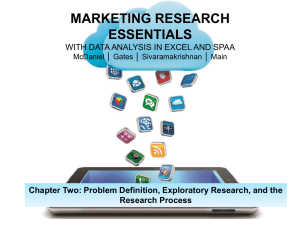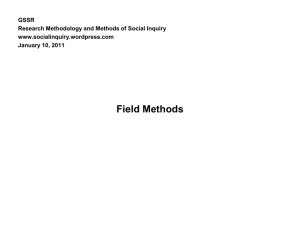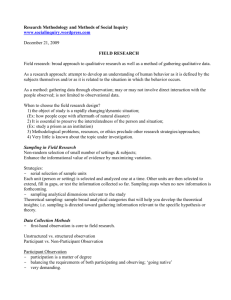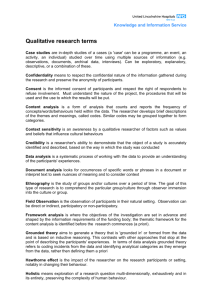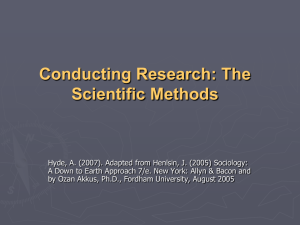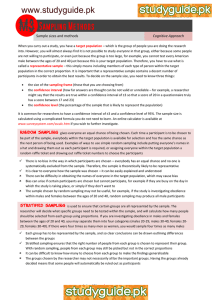Participant Observation
advertisement
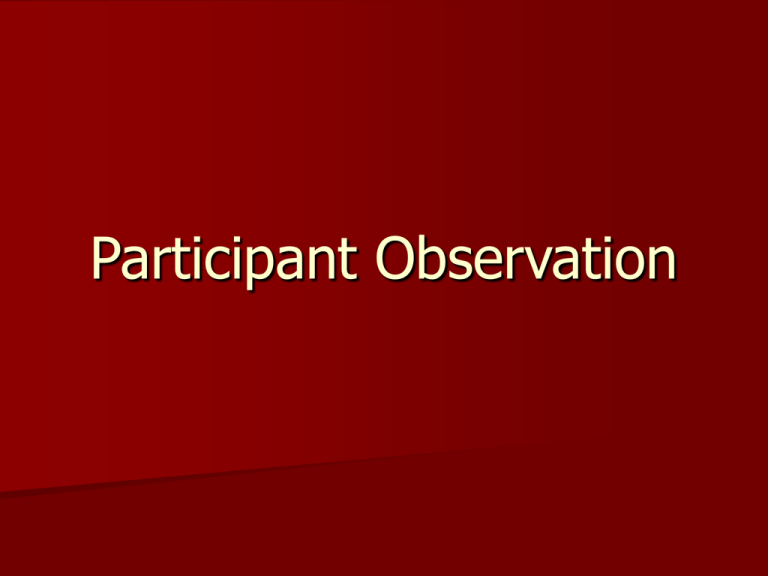
Participant Observation Criteria for Trustworthiness Credibility assesses the degree to which the report “rings true” to the participants studied. Dependability assesses the degree to which the research process is trackable. Confirmability assesses the connection between the conclusions drawn and the sources of data which support those conclusions. Transferability describes the level of description necessary to allow readers to determine whether the qualitative report can be applied to other topics or settings of interest. Dell Hymes’ SPEAKING (1972) Heuristic Framework Situation Key Genres Ends Instrumentality Participants Norms of Interaction Act Characteristics The Choreography of Participant Observation (Janesick, 1994) Like dance, researchers must be flexible and adaptive to the dynamic process There are three stages to participant observation: – The “warm-up” period – The “floor exercise” stage – The “cool-down” stage The “Warm-up” Period The researcher begins the process with general questions of interest – these questions will evolve throughout the research process. The literature review is written to achieve theoretical sensitivity. The researcher initiates a reflexive journal and a journal for field notes. The researcher selects the field site. The researcher decides the type of role they will assume. The researcher seeks to gain and sustain access to the site. Roles of the Researcher Observation Strategies – Complete-participant role – Participant-as-observer role – Observer-as-participant – Complete observer Degree of Involvement – Complete Member – Active Member – Peripheral Member Gaining and Sustaining Access The researcher needs to carefully assess the nature of informed consent given her goals, her desired role, and the community of interest. A gatekeeper (formal or informal) will be key to gaining access to your site – a formal gatekeeper can often offer consent for you to study her organization. Sponsors help you to establish relationships with other community members by taking an interest in your project. Informants are those members of the community that you go to for information about the community and for conducting “member checks.” Prolonged engagement in the field helps to ensure the greater credibility of the study. The “Floor Exercise” Period Sampling Constructing Field Notes and Visual Records Making ethical decisions Triangulating sources of data Sustaining elasticity Sampling Participants, Activities, and Scenes Maximum-variation sampling Typical case sampling Snowball sampling Theoretical construct sampling Critical case sampling Convenience sampling Constructing Field Notes Do not trust your memory – take notes during or soon after your observations take place. Take notes in stages – First, take initial notes to help you recall observations. – Second, take detailed and comprehensive notes filling in the initial notes. Field notes should include detailed descriptions, initial analysis as well as reflexive notes on the research process Field notes should be chronological The content of field notes will vary according to the purpose of the study, but should include the “who, what, when, where, and why” of the observations. Triangulating Sources of Data (Denzin, 1978) Use multiple Use multiple research Use multiple Use multiple and different sources of data and different methods of researchers theoretical perspectives The Iterative Process of Participant Observation: Remain Elastic The “Cool-Down” Period Data gathering is complete when saturation has been achieved. When data are repetitive and interpretations refined, saturation has been achieved. In order to determine saturation, the researcher must analyze data as it is collected. The researcher must keep her relationships with participants in mind when deciding how to leave the field. Additional member checks may be necessary as the researcher continues to write the research report.

